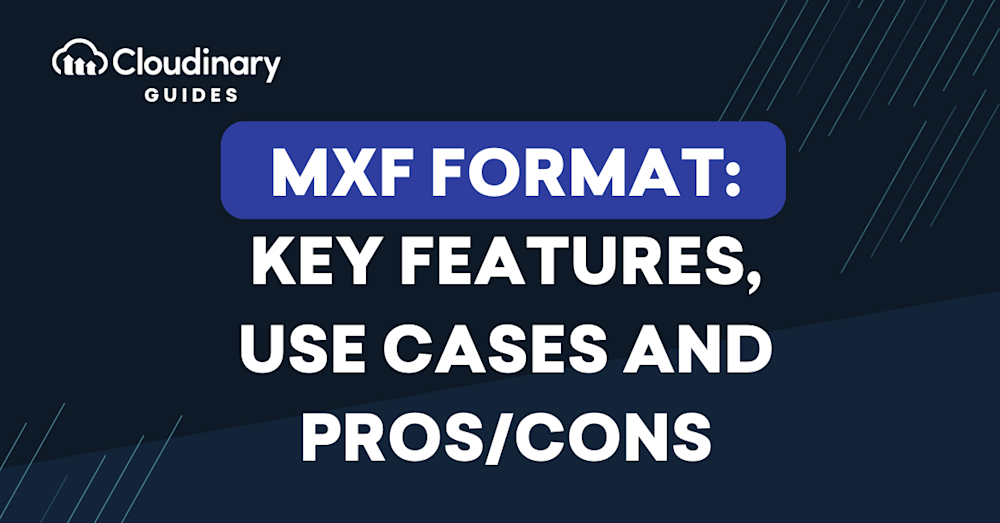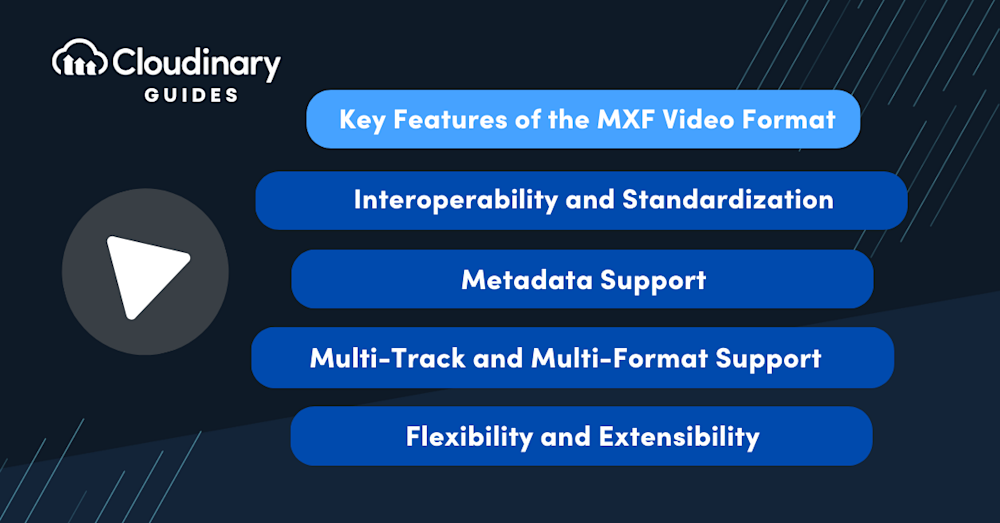What Is the MXF File Format (Material eXchange Format)?
The Material eXchange Format, commonly known as the MXF format, is a container that is primarily used for the exchange of audio-visual content. MXF files often store specific types of content, such as television advertisements, television archives, and movies. It was designed to address a range of issues associated with non-linear editing, content distribution, and digital archiving. The format encapsulates a variety of media components, including audio, video, and metadata, into a single file.
The MXF format is versatile and adaptable, supporting several compression schemes and data types. It has been widely adopted in the broadcast industry due to its ability to streamline workflows and enhance collaboration. Whether you are a broadcast professional, content creator, or simply someone interested in media technology, understanding the MXF format can be beneficial.
This is part of a series of articles about video formats.
In this article:
- History and Origin of the MXF File Format
- How to use MXF files?
- Material eXchange Format: Pros and Cons
- How to Open MXF Files
- Automated Video Format Conversion With Cloudinary
- FAQs
History and Origin of the MXF File Format
The MXF format was the result of a collective effort by media industry leaders to establish a common format for the exchange of audio-visual content. The initiative was led by the Pro-MPEG Forum, which began developing the MXF format in the late 1990s. The goal was to overcome the limitations of existing formats and create a more efficient and flexible solution for content exchange.
The development of the MXF format was driven by the transition from analog to digital technology in the broadcast industry. Digital technology introduced new challenges, including the need for interoperability and the management of metadata. The MXF format was designed to address these issues, providing a standardized solution for the exchange of digital content.
The MXF format was officially standardized by the SMPTE in 2004. Since then, it has been adopted by many broadcasters and media companies worldwide. It is now a fundamental part of modern broadcast workflows.
How to use MXF files?
Compress large files for storing and sharing
Video files are often large, which can slow down transfers between systems. Compression reduces file size for easier storage and sharing. Three key components handle this:
- Containers hold video and audio data.
- Codecs compress the data (typically lossy compression for videos).
- Formats define these specifications.
MXF is a container that works with multiple codecs to store and transfer data between platforms without compatibility issues.
Transfer footage from digital cameras to production software
MXF files are commonly used to move footage from high-end digital cameras to video editing platforms. Programs like Adobe Premiere Pro support MXF from brands like Sony XDCAM and Canon XF, enabling seamless import and editing.
Television, advertising, and movies
In creative industries, repurposing content for different platforms is essential. MXF simplifies moving files across systems, thanks to its codec flexibility. This makes it easier for editors, producers, and creatives to adapt footage for various uses, including social media and broadcast.
D-cinema distribution
Modern theaters rely on digital cinema prints (DCPs) instead of film reels. These are collections of digital files stored on drives, following standards set by SMPTE. MXF plays a key role in this system by enabling efficient distribution of high-quality digital movies with features like 3D and high frame rates.
Material eXchange Format: Pros and Cons
MXF Advantages
Interoperability
One of the main advantages of the MXF format is its interoperability. Unlike other formats, MXF is independent of the platform and can work with various systems and software. Plus, it supports a myriad of codecs, making it easy to work with different types of media.
High Quality
When it comes to quality, it’s designed to handle a variety of media types, including high-definition video, audio, and metadata, without compromising on quality, preserving it even after multiple transfers and edits.
Standardization
With MXF, you can be sure that your files will be compatible with a wide range of software and systems.
Versatility
MXF can encapsulate metadata and other related data. This feature enables professionals to manage, categorize, and track their files with ease, making it an all-in-one solution for media management.
Pro Tip!
Video Transformations on the Fly
Cloudinary allows you to easily transform your videos on the fly to any required format, style and dimension, and apply effects and other visual enhancements. Supported formats include WMV, WebM, OGV, MXF, MPEG, MP4, among others.
MXF Disadvantages
Accessibility
MXF files have limited accessibility because many standard video players and editing programs don’t natively support their codecs. As a result, importing MXF files into software like VLC or QuickTime can be challenging without additional codec installation.
File Size
Lastly, the MXF format’s high quality comes at a cost: file size. MXF files tend to be larger than other formats, which can pose storage and transfer issues.
How to Open MXF Files
On Mac
If you are a MacOS user and you want to open MXF Files you will need a third-party software like VLC Player.
- Start by downloading and installing VLC Media Player from the official website.
- Go to Finder on Mac and locate your MXF File.
- Right click and go to Open With -> VLC
On Windows
Though Windows doesn’t natively support MXF playback, several third-party programs and tools are available that make it a breeze to work with MXF files:
- VLC Media Player:
- A free and open-source media player that supports MXF files.
- Simply download, install, and open your MXF file through the media player.
- MXF Video Converter:
- Use a reliable video converter tool to convert MXF to a Windows-friendly format like MP4 or WMV.
- Several converters offer options to optimize video quality and compatibility.
- Professional Video Editing Software:
- Software like Adobe Premiere Pro or DaVinci Resolve can open and edit MXF files.
- While these programs cater to professional use, they also provide robust playback options.
Automated Video Format Conversion With Cloudinary
Cloudinary offers a versatile, effective, and efficient solution for managing media, replete with dynamic, automated optimization and delivery features. For example, setting the fetch_format parameter to auto (f_auto in URLs) causes Cloudinary to automatically select the format and codec based on the requesting browser. Chrome users would most likely receive a VP9-encoded WebM file; Safari users, an HEVC-encoded MP4 file. If a browser does not support either of those formats, Cloudinary delivers the video as an H.264-encoded MP4 file, which works in almost all browsers.
Interested? Have a try for free by first signing up for a free Cloudinary account.
FAQs
What video format is MXF?
MXF is a container video file format developed by the Society of Motion Picture and Television Engineers (SMPTE). It’s designed for the professional transfer of video content across different platforms, such as moving footage from cameras to post-production software. As a flexible format, MXF supports various codecs and can be converted into widely used video file types like MP4 or MOV, maintaining compatibility and workflow efficiency in broadcast and video production environments.
What does MXF mean?
MXF stands for Material eXchange Format, a name given by its creators to highlight its core function: exchanging video and audio content between different applications used in film and television production. As a container format, MXF ensures seamless interoperability across platforms in the broadcast and post-production workflows.
What program opens MXF files?
MXF files often use codecs that common media players like Windows Media Player or QuickTime don’t natively support. To view MXF files, you may need to convert them into more widely compatible formats, such as AVI or MPEG4, using a video file converter.


